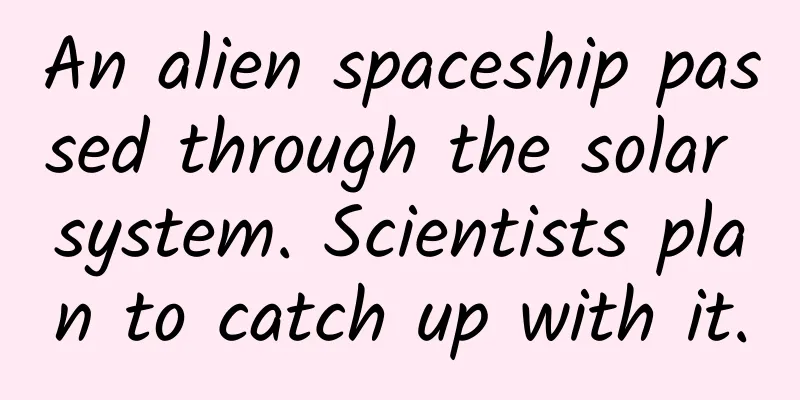An alien spaceship passed through the solar system. Scientists plan to catch up with it.

|
This article was reviewed by Liu Yan, Space Application Engineering and Technology Center, Chinese Academy of Sciences In October 2017, the interstellar visitor ‘Oumuamua passed through our solar system, leaving behind many mysteries. Not only was it the first interstellar object ever observed, but the limited data astronomers had from it as it hurtled out of the solar system left them scratching their heads. Even today, five years after this interstellar visitor flew past Earth, scientists are still unsure of its true identity and origin. In the end, the only way to get some real answers from this is to catch up with it. In a paper recently published on a preprint website, scientists from the UK and the US proposed a specific plan to catch up with Oumuamua. If this plan is implemented, a spacecraft launched from Earth in 2028 will catch up with Oumuamua 26 years later and take photos of it for astronomers to study. After that, the probe will have to travel for nearly 18 years and finally approach Oumuamua around 2050. Does extraterrestrial civilization exist? It brings inspiration. Human exploration will never stop. Excluding comets and asteroids, the Harvard professor believes that Oumuamua must be a product of alien technology. The search for intelligent life beyond Earth is endless—as evidenced by countless books and films. Most fictional accounts of close encounters involve a sublime connection, a meeting of enlightened minds and cultures amidst a peaceful exchange of superior technology. Scientific ideas like the Drake equation, which attempt to formalize the broader theoretical parameters of intelligent life beyond Earth, have yet to produce a definitive answer to the possibility of other life in the Milky Way. If intelligent aliens do exist, they have yet to leave any footprints. An artist's concept of the object 1I/2017 U1 ('Oumuamua). Unlike any object we have observed in the solar system, 'Oumuamua has an aspect ratio of 10:1. Image source: NASA However, one leading scientist says someone has already found signs of them. In 2017, the unknown celestial body ‘Oumuamua flew past the solar system. This may be our first official encounter with alien technology - wrote astrophysicist and Harvard professor Avi Loeb in his book "Aliens: The First Sign of Intelligent Alien Life" published on January 26. Alien technology may have already entered the solar system In his forthcoming book, Professor Loeb offers a convincing explanation for why ‘Oumuamua, an elongated, shaft-shaped object that zipped through our solar system in 2017, is more than just a space rock. He believes that Oumuamua may be one of the products of alien technology that no longer exists. The object came from the direction of Vega (25 light years away) and entered the plane of the solar system on September 6, 2017. "It entered the plane of the inner solar system's planetary orbits on September 6, 2017," Loeb wrote. "But the object's extremely hyperbolic trajectory ensures that it will only visit the solar system and will not stay." The trajectory of Oumuamua (2017 U1) in the solar system | NASA Oumuamua has a small but constant acceleration After ‘Oumuamua passed its perihelion, “it began to leave the solar system: its velocity, about 94,800 kilometers per hour (58,900 miles) relative to the sun, was high enough to ensure it escaped the sun’s gravitational pull,” Loeb wrote in his book. "It passed through the orbit of Venus and the Sun on September 29, passed by Earth on October 7, and is rapidly heading toward the interstellar direction in the direction of the constellation Pegasus." ‘Oumuamua’s acceleration is small but constant, which cannot be explained by the sun’s gravity. Strange object's acceleration baffles scientists Comets also gain acceleration when they release gas, which condenses into their signature tails. But ‘Oumuamua has no tail, and telescopes have not found any signs of byproducts associated with outgassing, such as dust or water vapor. Astronomers have been trying to eliminate one theory after another to figure out what’s causing ‘Oumuamua’s strange behavior. It’s not colliding with another object, nor is it gaining speed from the solar wind. One research team believes that the best explanation is that the "micro-comet" Oumuamua's tail has not been discovered due to its unusual elemental composition. Another team believes that Oumuamua is composed of frozen hydrogen, which is a modified small comet theory. Harvard professor claims ‘Oumuamua’s brightness is key to its origin However, the most interesting account comes from Professor Loeb, who believes that Oumuamua is not an interstellar object as we think it is, but a product of an alien civilization. "Long before we knew of 'Oumuamua's existence, it was already traveling toward us from the direction of Vega, only 25 light-years away," Loeb wrote in his book. However, ground-based and space-based observations that followed the object's outward trajectory confirmed that sunlight was reflecting off 'Oumuamua's surface. "The changing brightness of an object provides astronomers with valuable clues to its shape," Loeb wrote. "'Oumuamua's brightness varies by a factor of ten every eight hours, which we infer is the time it takes to complete one rotation. Illustration of 'Oumuamua spinning and spewing dust as it is heated by the Sun | ESA/Hubble, NASA, ESO, M. Kornmesser Harvard professor claims that Oumuamua is the product of alien civilization "'Oumuamua's bizarre brightness variations tell us that its shape is extreme, or that its length is at least five to ten times longer than its width," Loeb wrote. The evidence seems to point to a relatively small, cigar-shaped object. “This must be an unusual object,” reads the narration of the NASA video, The New Yorker reports, “and unfortunately, we won’t get any more observations of ‘Oumuamua; it’s too faint and too far away. Having ruled out the possibility that ‘Oumuamua is a comet or other asteroid, Professor Loeb believes that there is only one explanation left: this puzzling celestial body is the product of advanced alien technology. Extraordinary claims require extraordinary evidence "Our civilization has already sent five artificial objects into interstellar space: Voyager 1 and 2, Pioneer 10 and 11, and New Horizons," Loeb wrote. "This fact alone suggests our potential for venturing far and wide. The same was true of our ancestors farther in time." "And if other civilizations develop among the stars, wouldn't they have a strong desire to explore, to look beyond the familiar horizon for new things? None of this would be surprising given human behavior," Loeb concludes in the book. Needless to say, Loeb's conclusions about 'Oumuamua's origins are extraordinary. "Extraordinary claims require extraordinary evidence," said astronomer Carl Sagan, whose contributions to the search for extraterrestrial life are not underestimated by any scientist. Conceptual image of Oumuamua The theory of the extraterrestrial origin of celestial bodies opens up new prospects for exploration The evidence Loeb cites to support his Oumuamua theory is precisely that there is no other convincing explanation for it. "For me, extraordinary claims do not necessarily require extraordinary evidence," Loeb retorted to Sagan, "Extraordinary conservatism makes us extraordinary ignorant." For Loeb, as long as the possibility exists that ‘Oumuamua is an alien probe, ruling it out would be fooling ourselves. “If we accept that ‘Oumuamua could be the product of alien technology, a whole new horizon of discovery and exploration of evidence will open up for us,” Loeb wrote. Artist’s conception of ‘Oumuamua (Image credit: ESO and M. Kornmesser) Loeb risks (and has endured) being laughed at for his convictions. On the basis of history, the odds are stacked against his theory. Yet given the stark contrast between the statistical likelihood of life beyond Earth and the lack of evidence — the so-called Fermi paradox — it’s hard to deny the exciting possibility that technology from alien civilizations has indeed made its way to our solar system. Source: Tianwen Online (ID: tianwenzaixian) This article has been authorized. Please contact the original author for reprinting. |
<<: How long after drinking can you drive? These examples tell you the answer
>>: How to pour the perfect beer while watching a game?
Recommend
Download Wang Tong Knowledge Monetization Training Camp Notes Course_Free Online Reading
The secret to becoming an industry expert in 100 ...
Ten thousand words of dry goods summary: the most comprehensive interpretation of operational data indicators
Operations and data analysis are inseparable. Bus...
2021 Chen Changzhang's annual class + building personal IP, suitable for new media people who increase fans and realize monetization through short videos
2021 Chen Changzhang's annual class + buildin...
How to configure when renting and hosting a server?
Server leasing means that the server provider pro...
Lao Duan talks about OTT: Is there a piece of meat in cable live streaming?
Integrating cable live broadcast at the terminal ...
An information flow advertising landing page worthy of collection by all industry professionals
We all know that the task of most landing pages i...
New research from Peking University! Intestinal fungi are the "trigger" of polycystic ovary syndrome
In the field of women's health, polycystic ov...
Analysis of advertising cases of educational training institutions!
The winter vacation is approaching, and for pract...
What are the ways to make money with APP?
App developers often ask themselves a question: h...
Autumn healthy diet guide to help you stay healthy in autumn
As the saying goes, autumn is the season of harve...
A brief analysis of mobile Internet advertising fraud methods. How to prevent it?
1. Causes of Cheating Here I would like to first ...
7 content models for corporate TikTok accounts
What is the most popular social short video platf...
The Ministry of Industry and Information Technology issued a notice on 16 apps that infringe on user rights, including Dangdang and eDaijia
The Information and Communications Administration...
Cherries become the favorite during the Spring Festival. They are all big cherries, so why are they more expensive?
The Spring Festival is approaching, and fruit is ...









